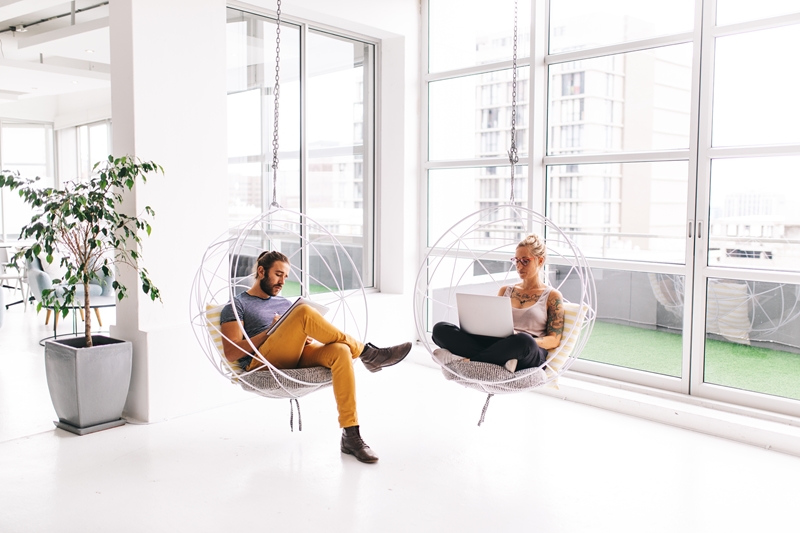Is hot desking worth it? Pros and cons explained

As companies in increasingly crowded cities look for ways to reduce their costs whilst also fulfilling the developing need for flexible working, a new trend has arisen: hot desking.
The practice is being adopted by companies from Deloitte to LEGO, but it has proved a controversial move with strong points against and in favour. Many businesses are striving to access the improved cooperation between teams and the cost saving potential that the technique promises. However a growing body of research suggests that it can be at best, annoying for workers and at worst, psychologically damaging.
So, what exactly does hot desking involve and what are the implications for a workplace?
What is hot desking?
The term ‘hot desking’ comes from the grim sounding naval practice of sharing bunks so save floor space aboard cramped ships. In the modern business world it refers to the practice of activity-based working where staff don’t have an assigned desk in their office space.
Instead they choose between various seating options which are claimed on a first come first served basis. People must clear their desks at the end of every working day so that space is ready to be claimed by anyone next time round.
 Hot desking
means sharing unassigned desks
Hot desking
means sharing unassigned desksPros of hot desking
Cost savings
Without a doubt one of the biggest advantages of hot desking for your company will be reduced real estate expenses. This is achieved largely through eliminating your wasted space taken up by providing desks for staff who do not want or need one.
JLL has reported that globally companies under-utilise 30-40% of their space on a typical workday. Hot desking allows businesses to reclaim this space and plan for the modern situation of having workers regularly working from home or being out at client meetings.
Provides flexibility for a new generation
At the heart of hot desking is the idea of flexibility. With a thriving millennial workforce who increasingly want perks such as working from home and flexible hours, hot desking can help to facilitate this mind set in your office.
Varied seating and area options also allows your staff to adapt their workspace to different tasks or even to how they are feeling on different days. Employees who need to work more in a team environment can arrange to do so in collaborative spaces, while those who prefer silence can find a separate space. This often provides a welcome contrast to the alternative open plan office where everyone must put up with their assigned spot.
 Clear desks can help reduce clutter and present a tidier image
Clear desks can help reduce clutter and present a tidier imageA cleaner office space
It can be easily over looked but hot desking can help create a cleaner aesthetic for your office environment. The enforced tidy desk policy where everyone must pack up their items every day to open all the workspaces backup for colleagues prevents clutter. It also gives a clear end to the day and can be useful for protecting confidential information.
Creating an atmosphere of collaboration
Offices are important creative hubs within your business where all your employees can gather to exchange information and insights. However, in a regimented assigned desk system certain groups of people may never get to meet in person.
Hot desking allows people to make full use of the office space and collaborate more freely with their team members. Finding alternative seating everyday also leads to contact with employees who would traditionally be far removed from your particular area. Increased integration between teams can also lead to the flattening of traditional workplace hierarchies.
Cons of hot desking
Psychological impact of not having a personal space
Personal space is important to all of us, hence why we enjoy having our own bedrooms in a house full of other people. Building a personal area in an office space can help people to concentrate and also feel safe and provided for. There are a few notable ways that not having an assigned desk area can harm people:
- Lack of consistency and an ever changing ‘first-come-first’ seating system can be challenging for employees
- Reduced privacy because of increased movement and less permanent desk features
- Teams accustomed to sitting and collaborating can find their working relationship broken up
 Hot desking can make
employees feel marginalised
Hot desking can make
employees feel marginalisedWhile these difficulties may not affect all employees, there is an increasing body of research to suggest that hot desking is impacting workers negatively. For example ‘the demands and resources arising from shared office spaces’ a study based on 1000 Australian workers, found that hot desking resulted in increased distrust, distractions, uncooperative behaviour, negative relationships and decreased perception of support from supervisors.
Before initiating a hot desking system, it is very important to make sure it is also what your employees want, or you may risk reducing productivity and motivation.
The need for increasingly flexible IT and printing resources
The need for mobility means that workers can no longer have a static desk PC that will only need to be set up and connected once. Instead employees must be able to connect portable technology to well-maintained wireless systems, notably internet access, charging facilities and easy printing.
This increases the need for good technology logistics which allow all employees to be productive wherever they choose to work. Tools such as integrated Managed Print Services and workflow organisation can help companies to master these issues.
The importance of flexibility in the modern office space
The dramatic rise in uptake of hot desking represents a wider movement towards a modern flexible office space. If a hot desking approach will work specifically for your business, it is well worth considering how you can provide your employees with the technology and connectivity that will allow them to be productive whether ever they want to work.
At Brother we know that a busy office needs seamless connectivity. We offer a variety of managed printing services to make your business printing totally hassle free and optimised to your way of working. Find out how our experts can help you.
Get in touch

Resource Library
Be the first to receive exclusive offers and the latest news on our products and services directly in your inbox



.jpg?h=720&iar=0&w=1920&rev=36358aeeea934b07bce65a5d230d3519)
